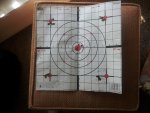So I finally broke down and bought a Wheeler Engineering FAT torque wrench. I decided to do some testing to find the ideal inch pounds for my action screws. I went from 45" lbs. to 65" lbs. in 5 lb increments. I shot a three shot group at a distance of 100 yards with each setting here are my results.
Rifle:
FN Patrol action
McM A5 Bedded in Devcon w/ pillars installed
Bartlein 1-10 5r @ 23" chambered in 308 W.
Premier Heritage 3-15
Handload:
190 SMK
40.5 IMR4064
Lapua case
BR2 primer
2.8355" COAL
Group Sizes:
45" lbs.: 0.460
50" lbs.: 0.374
55" lbs.: 0.289
60" lbs.: 0.573
65" lbs.: 0.874

Rifle:
FN Patrol action
McM A5 Bedded in Devcon w/ pillars installed
Bartlein 1-10 5r @ 23" chambered in 308 W.
Premier Heritage 3-15
Handload:
190 SMK
40.5 IMR4064
Lapua case
BR2 primer
2.8355" COAL
Group Sizes:
45" lbs.: 0.460
50" lbs.: 0.374
55" lbs.: 0.289
60" lbs.: 0.573
65" lbs.: 0.874


